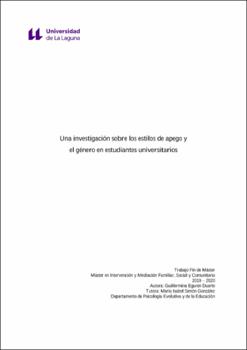Una investigación sobre los estilos de apego y el género en estudiantes universitarios
Fecha
2021Resumen
La Teoría del Apego (1969) cataloga a los seres humanos en diferentes grupos en función
de cómo nos vemos a nosotros mismos y de la visión que tenemos de los demás. En esta
investigación nos interesa conocer cuáles son los tipos de apego (seguro, ansioso –
ambivalente, evitativo) que se dan en una muestra universitaria y analizar las diferencias en
las dimensiones del apego (confianza, incomodidad con la intimidad, necesidad de
aprobación, preocupación por las relaciones y relaciones como secundarias) en función de
las variables sexo, edad y titulación. Se trata de una investigación descriptiva, no
experimental. Participaron 152 estudiantes (44 hombres y 108 mujeres) de la Facultad de
Educación y de la Facultad de Ciencias Políticas y Sociales de la Universidad de La Laguna.
Se administró la versión española del Cuestionario de Estilos de Apego, el Attachment Style
Questionnaire (ASQ) (Feeney, Noller y Hanrahan, 1994). El estilo de apego adulto, y las
dimensiones que lo componen, están relacionadas con las variables independientes analizadas.
Se llevaron a cabo análisis de varianzas (ANOVAS) simples y un análisis de conglomerados
jerárquico y confirmatorio. Cabe destacar que los resultados obtenidos no fueron tan potentes
como se esperaba y las hipótesis solo se confirmaron parcialmente. En esta muestra
predomina un tipo de apego inseguro, el apego preocupado (32,9%). En cuanto al sexo, los
varones presentan valores significativos en algunas dimensiones del apego evitativo y del
apego ansioso-ambivalente, mientras que las mujeres lo hacen en el seguro y el ansiosoambivalente. En las titulaciones Sociales existe una tendencia hacia el apego huidizo–ausente
y en las titulaciones Educativas predomina el preocupado. A menor edad se tiende al apego
ansioso–ambivalente. Se necesita tratar los aspectos socioemocionales que promuevan el
bienestar de los profesionales que trabajan en contextos relacionales. Se discuten las
limitaciones del estudio. Attachment theory (1969) catalogues human beings in different groups according to how
we see ourselves and the vision we have of others. In this research we are interested in
knowing which are the types of attachment (secure, anxious – ambivalent, avoidant) what are
given in a university sample and analyze the differences in the dimensions of attachment
(Confidence, Preoccupation with Relationships, Discomfort with Closeness, Need for Approval and Relationships as Secondary) according to sex, age and degree variables. This is
descriptive research, not experimental research. 152 students (44 men and 108 women) from
the Faculty of Education and the Faculty of Political and Social Sciences of the University of
La Laguna participated. The Spanish version of the Attachment Style Questionnaire (ASQ)
(Feeney, Noller and Hanrahan, 1994) was administered. The style of adult attachment and the
dimensions that compose it are related to the independent variables analyzed. Simple variance
analysis (ANOVAS) and a hierarchical and confirmatory cluster analysis were carried out. It
should be noted that the results obtained were not as strong as expected and the hypothesis
were only partially confirmed. In this sample there is a predominant type of insecure
attachment, preoccupied attachment (32.9%). As for sex, males present significant values in
some dimensions of avoidance attachment and anxious – ambivalent attachment, while
females do so in secure and the anxious – ambivalent attachment. In Social Degrees there is a
tendency to fearful-avoidant attachment and in Educational Degrees the preoccupied ones
predominates. Younger people tend to anxious – ambivalent attachment. Socio – emotional
aspects that promote the well – being of professionals working in relational contexts needs to
be treated. The limitations of the study are discussed.





